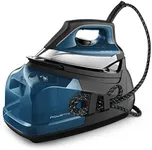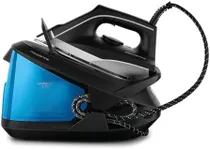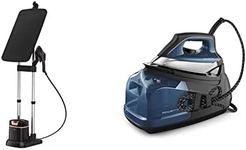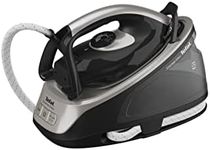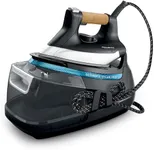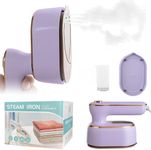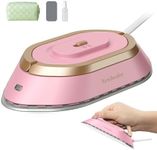Buying Guide for the Best Iron Steam Stations
When it comes to choosing an iron steam station, it's important to consider a few key specifications to ensure you get the best fit for your needs. Iron steam stations are designed to provide powerful steam output and make ironing faster and more efficient. By understanding the key features and how they impact performance, you can make an informed decision and select the right model for you.Steam OutputSteam output is the amount of steam the iron can produce, usually measured in grams per minute (g/min). This spec is important because higher steam output can help remove wrinkles more effectively and quickly. Steam output can range from around 90 g/min to over 200 g/min. If you have a lot of heavy fabrics or need to iron large quantities of clothes, a higher steam output will be beneficial. For lighter fabrics or occasional use, a lower steam output may suffice.
Water Tank CapacityThe water tank capacity determines how much water the iron can hold, which in turn affects how long you can iron without needing to refill. This is important for convenience and efficiency. Capacities can range from around 1 liter to over 2 liters. If you do a lot of ironing in one session, a larger tank will be more convenient as it reduces the frequency of refills. For smaller ironing tasks, a smaller tank may be adequate.
Heat-Up TimeHeat-up time is the duration it takes for the iron to be ready for use after being turned on. This is important for saving time and convenience. Heat-up times can vary from under 2 minutes to around 5 minutes. If you need to iron quickly or often find yourself in a rush, a shorter heat-up time will be more suitable. For less frequent use, a longer heat-up time may not be a significant issue.
PressurePressure, measured in bars, indicates the force with which steam is delivered. Higher pressure can penetrate fabrics more effectively, making it easier to remove stubborn wrinkles. Pressure levels typically range from 4 bars to over 7 bars. For heavy fabrics or tough wrinkles, higher pressure is advantageous. For lighter fabrics or less demanding ironing tasks, lower pressure may be sufficient.
Soleplate MaterialThe soleplate is the bottom part of the iron that comes into contact with the fabric. Common materials include stainless steel, ceramic, and non-stick coatings. This spec is important for smooth gliding and even heat distribution. Stainless steel is durable and glides well, ceramic offers good heat distribution and is gentle on fabrics, and non-stick coatings prevent sticking. Choose a soleplate material based on your fabric types and personal preference for ease of use.
WeightThe weight of the iron steam station affects how easy it is to handle and maneuver. This is important for comfort during use. Weights can vary significantly, with some models being lightweight and others more substantial. If you have a lot of ironing to do or prefer a lighter iron for ease of use, opt for a lighter model. If you prefer a more solid feel or need extra pressure for heavy fabrics, a heavier model may be more suitable.
Anti-Scale SystemAn anti-scale system helps prevent the build-up of limescale, which can affect the performance and longevity of the iron. This is important for maintaining consistent steam output and prolonging the life of the appliance. Some models have built-in anti-scale systems, while others may require manual descaling. If you live in an area with hard water or want to minimize maintenance, look for a model with an effective anti-scale system.
